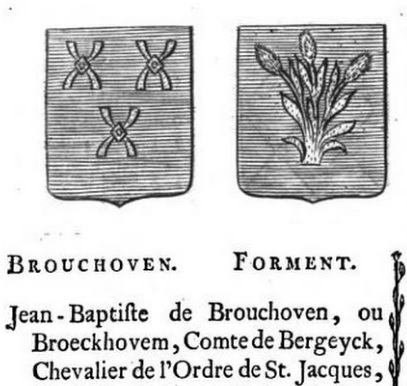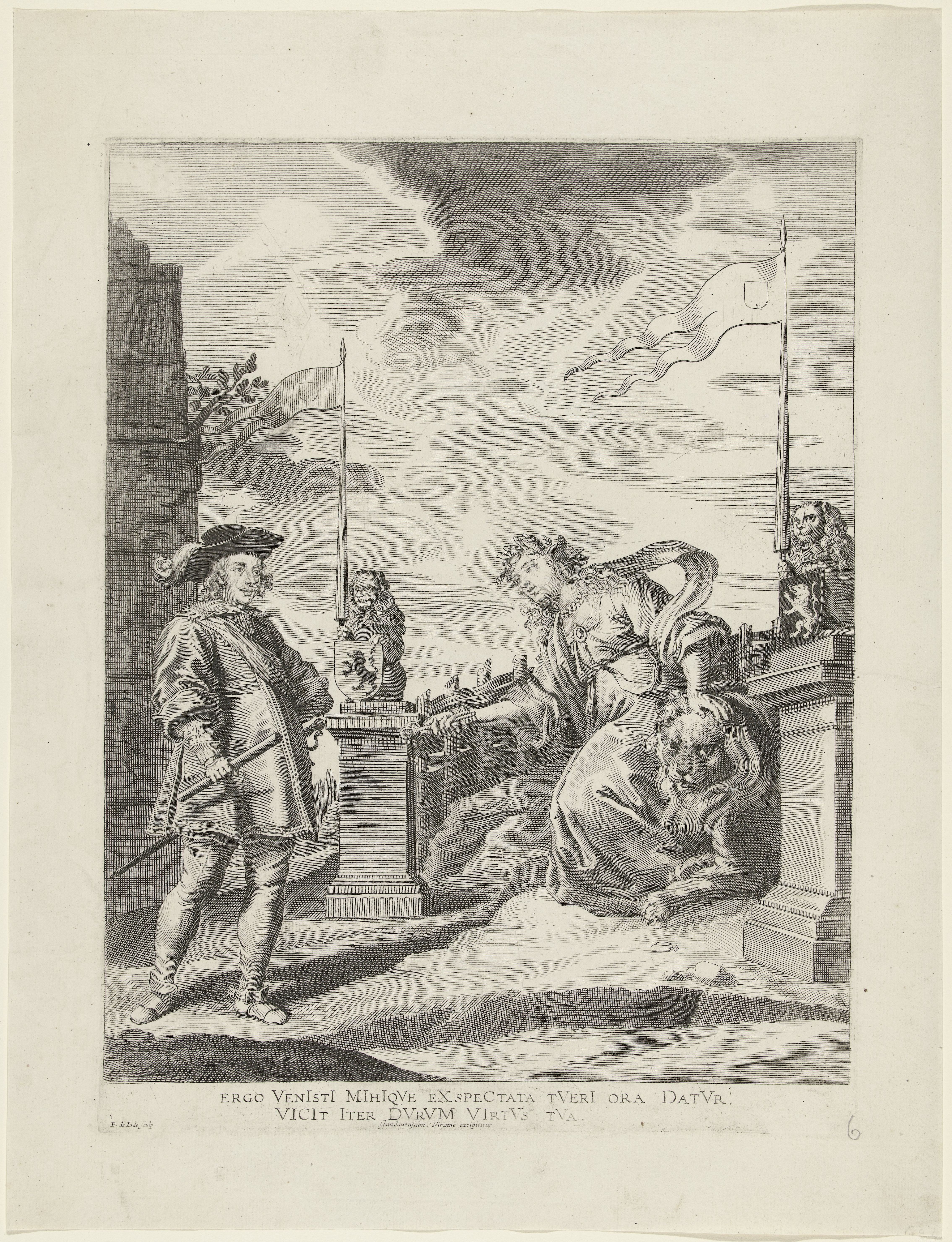|
Léon-Jean De Paepe
Léon-Jean de Paepe (1610–1685), lord of Glabbeek, was an officeholder and statesman in the Spanish Netherlands. After serving on the Council of Brabant in Brussels and on the Supreme Council of Flanders in Madrid, De Paepe was appointed president of the Privy Council of the Habsburg Netherlands in 1674. He died on 8 August 1685. His son Gilles-Dominique married Catherine de Brouchoven, daughter of Helena Fourment. Works De Paepe was the author of a manuscript treatise on the Joyous Entry A Joyous Entry (; ) is a ceremonial event marking the entry into a city by a monarch, prince, duke, or governor in parts of modern-day Belgium. Originating in the Middle Ages, it generally coincided with the affirmation or extension of the city' ... entitled ''Remarques sur la joyeuse entrée de S.M. comme duc de Brabant''.''Catalogue de livres de la bibliothèque de feu messire L. Deroovere De Roosemeersch'' (Brussels, 1845), 116. References {{DEFAULTSORT:Paepe, Leon-Jean de People ... [...More Info...] [...Related Items...] OR: [Wikipedia] [Google] [Baidu] |
Charles II Of Spain
Charles II (6 November 1661 – 1 November 1700) was King of Spain from 1665 to 1700. The last monarch from the House of Habsburg, which had ruled Spain since 1516, he died without an heir, leading to a European Great Power conflict over the succession. For reasons still debated, Charles experienced lengthy periods of ill health throughout his life. This made the question of who would succeed him central to European diplomacy for much of his reign, one historian writing that "from the day of his birth, they were waiting for his death". The two main candidates were the Austrian Habsburg Archduke Charles, and 16-year-old Philip of Anjou, grandson of Charles' half-sister Maria Theresa and Louis XIV of France. Shortly before his death in November 1700, Charles named Philip his heir, but the acquisition of an undivided Spanish Empire by either France or Austria threatened the European balance of power. Failure to resolve these issues through diplomacy resulted in the 1701 to ... [...More Info...] [...Related Items...] OR: [Wikipedia] [Google] [Baidu] |
Charles De Hovyne
Charles de Hovyne (1596–1671), lord of Gouvernies, Granbray, Winckel, Steenkercke, etc., was president of the Privy Council of the Habsburg Netherlands from 1653 to 1671, and a key participant in and commentator upon the government of the Habsburg Netherlands.Emile Van Arenbergh, "Hovyne (Charles de)", ''Biographie Nationale de Belgique''vol. 9(Brussels, 1887), 563–567. Life Charles de Hovyne, son of Laurent de Hovyne, counsel to the States of Tournai, was baptized in the church of St Jacques, Tournai, on 20 April 1596. After studying civil law at Leuven University, he became a barrister in pleas before the Great Council of Mechelen, and in 1628 a member of the court. In 1642 he became a privy councillor, and in 1647 a councillor of state. In 1653 he replaced Pieter Roose as president of the Privy Council. He died in Brussels on 13 April 1671, and was buried in the Chapel Church, where a monumental tomb designed by Jan van Delen was erected. He was married to Marie de Ga ... [...More Info...] [...Related Items...] OR: [Wikipedia] [Google] [Baidu] |
Glabbeek
Glabbeek () is a municipality located in the Belgian province of Flemish Brabant. The municipality comprises the populated places of Attenrode, Bunsbeek, Glabbeek proper, Kapellen, and Zuurbemde. On January 1, 2006, Glabbeek had a total population of 5,189. The total area is 26.78 km2 which gives a population density Population density (in agriculture: Standing stock (other), standing stock or plant density) is a measurement of population per unit land area. It is mostly applied to humans, but sometimes to other living organisms too. It is a key geog ... of 194 inhabitants per km2. References External links * Official website- Available only in Dutch Municipalities of Flemish Brabant {{FlemishBrabant-geo-stub ... [...More Info...] [...Related Items...] OR: [Wikipedia] [Google] [Baidu] |
Spanish Netherlands
The Spanish Netherlands (; ; ; ) (historically in Spanish: , the name "Flanders" was used as a '' pars pro toto'') was the Habsburg Netherlands ruled by the Spanish branch of the Habsburgs from 1556 to 1714. They were a collection of States of the Holy Roman Empire in the Low Countries held in personal union by the Spanish Crown. This region comprised most of the modern states of Belgium and Luxembourg, as well as parts of northern France, the southern Netherlands, and western Germany, with the capital being Brussels. The Army of Flanders was given the task of defending the territory. The Imperial fiefs of the former Burgundian Netherlands had been inherited by the Austrian House of Habsburg from the extinct House of Valois-Burgundy upon the death of Mary of Burgundy in 1482. The Seventeen Provinces formed the core of the Habsburg Netherlands, which passed to the Spanish Habsburgs upon the abdication of Emperor Charles V in 1556. When part of the Netherlands separated to ... [...More Info...] [...Related Items...] OR: [Wikipedia] [Google] [Baidu] |
Council Of Brabant
The Council of Brabant was the highest law court in the historic Duchy of Brabant The Duchy of Brabant, a Imperial State, state of the Holy Roman Empire, was established in 1183. It developed from the Landgraviate of Brabant of 1085–1183, and formed the heart of the historic Low Countries. The Duchy comprised part of the Bu .... It was presided over by the chancellor of Brabant. One of its functions was to determine that new legislation was not contrary to the rights and liberties established in the Joyous Entry. The Belgian Federal Parliament now sits in the building that was designed in the late 18th century by Gilles-Barnabé Guimard as the Palace of the Council of Brabant. Abolition On 1 January 1787, Emperor Joseph II decreed the abolition of the Council of Brabant, which had resisted his reforming measures as conflicting with the established liberties of the duchy, and ordered that it be replaced with a number of tribunals to be newly instituted. On 20 April the ... [...More Info...] [...Related Items...] OR: [Wikipedia] [Google] [Baidu] |
Supreme Council Of Flanders
The Supreme Council of Flanders and Burgundy (''Consejo Supremo de Flandes y Borgoña'' (i.e. Flanders and Burgundy), or simply ''Consejo de Flandes'') was a governing institution in the Spanish Empire responsible for advising the king of Spain on the exercise of his prerogatives in the Spanish Netherlands. This territory comprised most of the modern states of Belgium and Luxembourg, as well as parts of northern France, the southern Netherlands, and western Germany, particularly regarding ecclesiastical nominations, the appointment of high officials, royal pardons, and awards of honours such as knighthoods and noble titles. History The Supreme Council of Flanders was first founded in 1588, under Philip II of Spain, but was disbanded at his death, when the sovereignty of the Spanish Netherlands passed to Albert VII of Austria, ruling on behalf of his wife, the Infanta Isabella. The council was re-established in 1627 under Philip IV of Spain Philip IV (, ; 8 April 160517 Septe ... [...More Info...] [...Related Items...] OR: [Wikipedia] [Google] [Baidu] |
Privy Council Of The Habsburg Netherlands
The Privy Council or Secret Council (, ) was one of the three "collateral councils" (along with the Council of Finance and Council of State) that together formed the highest government institutions of the Habsburg Netherlands. Based in Brussels, it was particularly charged with legal and administrative questions. History The Council was founded on 1 October 1531 by Emperor Charles V. . Accessed 3 April 2017. He prescribed a president, eight councillors, and a secretary. |
Léon De Herckenrode
Baron Jacques Salomon François Joseph Léon de Herckenrode (1818–1880) was a Belgian genealogist. Life Herckenrode was born in Huy on 15 March 1818, the son of Auguste-Joseph de Herckenrode and Pauline-Charlotte de Berlaere.Emile Brouette, "Herckenrode (Jacques Salomon François Joseph Léon de)", ''Biographie Nationale de Belgique''vol. 35(Brussels, 1969), 412-413. He spent most of his life in Sint-Truiden. In 1846 he became a corresponding member of the Académie d'Archéologie de Belgique, frequently publishing in the ''Annales de l'Académie d'Archéologie de Belgique''. He died in Ghent on 22 October 1880. Publications * ''Vie de la comtesse Marie d'Oyenbrugge, dite de Duras, première supérieure du couvent de Berlaymont'' (Brussels, 1844) * ''Collection de tombes, épitaphes et blasons recueillis dans les églises et couvents de Hesbaye'' (Ghent, 1845) * ''Notice historique sur la commune de Rummen et sur les anciens fiefs de Grasen, Wilre, Binderveld et Weyer, en Hesbay ... [...More Info...] [...Related Items...] OR: [Wikipedia] [Google] [Baidu] |
Helena Fourment
Helena (or Hélène) Fourment (11 April 1614 – 15 July 1673) was the second wife of Baroque painter Peter Paul Rubens. She sat for a few portraits by Rubens, and also modeled for figures in Rubens' religious and mythological paintings. Family Helena Fourment was the youngest child of Daniël Fourment the elder, a wealthy Antwerp silk and tapestry merchant, and Clara Stappaerts. She had four brothers and six sisters. After his death, her father left to his son Daniël II an important collection of tapestries of Oudenaarde, Brussels and Antwerp, 35 paintings of his son-in-law Rubens, a large painting of Jordaens and several works of Italian masters. Most of her sisters married into important families. Daniel I Fourment, died 1643 : marr. Clara Stappaerts. ** Peeter Fourment, born 1590:''Married to Antonia van Hecke''. ** Daniel II Fourment, Lord of Wijtvliet, born 1592:''married to Clara Brant, sister of Isabella Brant (1591–1626)''. ** Clara Fourment, (1593-1643):''mar ... [...More Info...] [...Related Items...] OR: [Wikipedia] [Google] [Baidu] |
Joyous Entry
A Joyous Entry (; ) is a ceremonial event marking the entry into a city by a monarch, prince, duke, or governor in parts of modern-day Belgium. Originating in the Middle Ages, it generally coincided with the affirmation or extension of the city's civic rights and privileges. Joyous Entries are primarily associated with the historic Duchy of Brabant and County of Flanders and continue in modern-day Belgium where the most recent Joyous Entries took place in 2013. The term is also occasionally used in relation to royal entries in Medieval France, Luxembourg, Hungary, Scotland, and elsewhere.Bell & Hawell Informat ... [...More Info...] [...Related Items...] OR: [Wikipedia] [Google] [Baidu] |
People Of The Eighty Years' War
The term "the people" refers to the public or common mass of people of a polity. As such it is a concept of human rights law, international law as well as constitutional law, particularly used for claims of popular sovereignty. In contrast, a people is any plurality of persons considered as a whole. Used in politics and law, the term "a people" refers to the collective or community of an ethnic group or nation. Concepts Legal Chapter One, Article One of the Charter of the United Nations states that "peoples" have the right to self-determination. Though the mere status as peoples and the right to self-determination, as for example in the case of Indigenous peoples (''peoples'', as in all groups of indigenous people, not merely all indigenous persons as in ''indigenous people''), does not automatically provide for independent sovereignty and therefore secession. Indeed, judge Ivor Jennings identified the inherent problems in the right of "peoples" to self-determination, as i ... [...More Info...] [...Related Items...] OR: [Wikipedia] [Google] [Baidu] |



